A UTAUT-Based Framework for Analyzing Users’ Intention to Adopt Artificial Intelligence in Human Resource Recruitment: A Case Study of Thailand
Abstract
1. Introduction
2. Literature Reviews
2.1. Recruitment Overview
2.2. Digital Era and Artificial Intelligence in Recruitment
2.3. The Unified Theory for Acceptance and Use of Technology (UTAUT)
3. Theoretical Background
3.1. Development of Influencing Factors toward the Intention to Use AI in Recruitment
3.1.1. Performance Expectancy
3.1.2. Effort Expectancy
3.1.3. Social Influence
3.1.4. Facilitating Conditions
3.1.5. Privacy and Security
3.1.6. Trust in AI Technology
3.1.7. Perceived Values
3.1.8. Perceived Autonomy
3.2. Proposed Structural Model
4. Research Design and Methodology
4.1. Research Design
4.1.1. Secondary Research
4.1.2. In-Depth Interviews
4.1.3. Questionnaire

4.2. Sampling Plan
4.3. Data Analysis
5. Results and Discussion
5.1. Reliability and Validity
5.2. Discriminant Validity Test
5.3. Multicollinearity Test
5.4. Structural Model Analysis
5.5. Discussion
- (1)
- Perceived value, which has a direct impact on the intention to adopt AI in recruitment, aligns with findings from the acceptance of mobile payment solutions [82] and the adoption of assistance products such as smart speakers, voice assistance, and home appliances [71]. This means that HR and recruitment professionals are more likely to adopt AI when they perceive the benefits of AI in the recruitment process.
- (2)
- Perceived autonomy positively affects the intention to embrace AI in the hiring process, in alignment with other technology adoption studies, including intelligent personal assistants [99], IoT adoption [54], and online course utilization [100]. Perceived autonomy directly impacts the intent to adopt AI in recruitment. This underscores the significance of granting HR and recruitment professionals the autonomy to make choices regarding AI integration.
- (3)
- (4)
- Facilitating conditions also directly influence the users’ intent in accepting AI-based recruitment software, which is also aligned with autonomous car adoption research [121] and a ChatGPT adoption study [122]. The facilitating conditions are essential, and this finding highlights the importance of creating a supportive environment for AI integration.
- (5)
- For the indirect variables, it is worth highlighting the influence of social influence (SI) on perceived value (PV). This suggests that social influence has a clear and positive impact on perceived value, which, in turn, plays a direct role in shaping individuals’ intention to adopt AI-based recruitment systems. This relationship is consistent with a mobile payment acceptance study [82]. Similarly, trust in AI technology (TA) was found to have a positive effect on effort expectancy (EE). This implies that individuals’ trust in AI technology directly influences their expectations regarding the ease of using AI systems. This link was substantiated by a study on mobile payment adoption [65].
- (6)
- Privacy and security may not directly impact the intention to use AI in the hiring process. However, the respondents exhibited strong expectations regarding safety and data privacy in AI-based recruitment. They were somewhat uncertain about the honesty of AI developers. Nevertheless, it remains crucial to establish a strong foundation for privacy and security when implementing AI platforms in recruitment, in accordance with Thailand’s PDPA law [37].
6. Conclusions
6.1. Theoretical Implications
6.2. Managerial Implications
6.3. Limitations and Recommendation
Author Contributions
Funding
Data Availability Statement
Acknowledgments
Conflicts of Interest
Appendix A
| Construct | Measurement Item | Source |
|---|---|---|
| Performance Expectancy | PE1: I think AI is useful in recruitment | [38,73] |
| PE2: I think that AI will make recruitment process faster | ||
| PE3: I think AI can increase efficiency of recruitment work | ||
| PE4: I think using AI can help analyze candidates more accurately | ||
| Effort Expectancy | EE1: I would find the AI based recruitment software easy to use | [38,73] |
| EE2: I think it would be easy to learn how to use the interface of AI based recruitment software | ||
| EE3: For me, it will not take long to be skillful in using AI in recruitment | ||
| EE4: I think AI in recruitment would be flexible for use. | ||
| Social Influence | SI1: My decision to use AI in recruitment would be based on proportion of coworkers who use the software or system | [38,69,73] |
| SI2: Those who use AI in recruitment would have more advantages than those who do not | ||
| SI3: With the rapid technology trend, AI integrated in recruitment is necessary for my company | ||
| SI4: I think the introduction of AI in recruitment into our company will be trendy in my industry | ||
| Facilitating Conditions | FC1: I expect to call a technical support team in case of facing any problems | [38,69,73] |
| FC2: I expect that the system would be available in both computer and mobile devices | ||
| FC3: I think guidance would be available in AI based recruitment system | ||
| Privacy and Security | PS1: I expect that AI based recruitment software will be safe and secure | [54] |
| PS2: I expect AI based recruitment software will strictly comply data privacy policy regarding Personal Data Protection Act | ||
| PS3: I feel safe and protected by the use of encryption | ||
| PS4: I think AI software developer will protect and ensure safety of users’ personal data. | ||
| Trust in Technology of AI | TA1: I trust that AI algorithm is reliable in screening candidates to match organization’s requirement | [89] |
| TA2: I trust that AI based recruitment software has reliable database to complete recruitment | ||
| TA3: I think there will be a government organization to ensure AI based recruitment software is secured | ||
| TA4: I trust that AI software developer is honest and will not take advantage over user’s information | ||
| Perceived Value | PV1: I think that using AI in recruitment is worth investing | [97] |
| PV2: I feel that using AI can remain quality of recruitment process consistently. | ||
| PV3: I realize that using AI in recruitment will give the organization the social approve | ||
| PV4: I feel that using AI in recruitment will make impression on candidates | ||
| Perceived Autonomy | PA1: Using AI in recruitment will allow recruiters/HR officers to have more freedom to develop preferred skills and tasks | [54] |
| PA2: Using AI will give recruiters/HR officers the opportunity to better coordinate with candidates | ||
| PA3: Utilizing AI will provide recruiters and HR officers with more flexibility to manage other essential responsibilities more effectively | ||
| PA4: I think AI in recruitment will reduce the number of decisions to get the optimal results | ||
| Intention to Use | IU1: Using AI based recruitment software is a good and modern idea | [38] |
| IU2: I like the idea of using AI in recruitment | ||
| IU3: The AI based recruitment software makes me more interested | ||
| IU4: I have a high wiliness to use AI in recruitment |
References
- Bandi, G.N.S.; Kumar, D.G.P. A study on recruitment and selection practices—A theoretical approach. IJRDO J. Bus. Manag. 2017, 3, 183–191. [Google Scholar]
- Nanor, A.; Owusu, E.; Senyah, M.M.; Owusu, E.K.O.; Agyei, S.K. Recruitment and Selection Policies and Procedures and Their Effects on Organizational Performance: A Case Study. Tech. Soc. Sci. J. 2022, 35, 405–417. [Google Scholar]
- Chapman, D.S.; Webster, J. The Use of Technologies in the Recruiting, Screening, and Selection Processes for Job Candidates. Int. J. Sel. Assess. 2003, 11, 113–120. [Google Scholar] [CrossRef]
- Holm, A.B. E-recruitment: Towards an Ubiquitous Recruitment Process and Candidate Relationship Management. Ger. J. Hum. Resour. Manag. 2012, 26, 241–259. [Google Scholar] [CrossRef]
- O’Donovan, D. HRM in the Organization: An Overview. In Management Science: Foundations and Innovations; Machado, C., Davim, J.P., Eds.; Springer International Publishing: Cham, Germany, 2019; pp. 75–110. [Google Scholar]
- Talent Trends 2022 Michael Page The Great X Report Thailand 2022. Available online: https://ukabc.org.uk/wp-content/uploads/2022/06/The-Great-X-Report-Thailand.pdf (accessed on 2 April 2023).
- Jatoba, M.; Gutierriz, I.; Fernandes, P.O.; Teixeira, J.P.; Moscon, D. Artificial intelligence in the recruitment & selection: Innovation and impacts for the human resources management. In Proceedings of the 43rd International Scientific Conference on Economics and Social Development, Aveiro, Portugal, 15–16 July 2019; pp. 96–104. [Google Scholar]
- Johnson, R.D.; Stone, D.L.; Lukaszewski, K.M. The benefits of eHRM and AI for talent acquisition. J. Tour. Futures 2021, 7, 40–52. [Google Scholar] [CrossRef]
- Dhamija, P. E-recruitment: A roadmap towards e-human resource management. Res. World 2012, 3, 33–39. [Google Scholar]
- van Esch, P.; Black, J.S.; Ferolie, J. Marketing AI recruitment: The next phase in job application and selection. Comput. Hum. Behav. 2019, 90, 215–222. [Google Scholar] [CrossRef]
- Vimalkumar, M.; Sharma, S.; Singh, J.; Dwivedi, Y. ‘Okay google, what about my privacy?’: User’s privacy perceptions and acceptance of voice based digital assistants. Comput. Hum. Behav. 2021, 120, 106763. [Google Scholar] [CrossRef]
- Marikyan, D.; Papagiannidis, S.; Rana, O.F.; Ranjan, R.; Morgan, G. “Alexa, let’s talk about my productivity”: The impact of digital assistants on work productivity. J. Bus. Res. 2022, 142, 572–584. [Google Scholar] [CrossRef]
- Balakrishnan, J.; Dwivedi, Y. Conversational commerce: Entering the next stage of AI-powered digital assistants. Ann. Oper. Res. 2021, 1–35. [Google Scholar] [CrossRef]
- Pujari, V.; Sharma, Y.; Burate, M.; Prof, A.; Jagdishprasad, S.; Tibrewala, J. Application in Artificial Intelligence. Contemp. Res. 2021, 39–44. Available online: https://www.researchgate.net/publication/352507965_Application_in_Artificial_Intelligence (accessed on 23 November 2023).
- Songmuang, P.; Sirisup, C.; Suebsriwichai, A. Missing Link Prediction Using Non-Overlapped Features and Multiple Sources of Social Networks. Information 2021, 12, 214. [Google Scholar] [CrossRef]
- Tanantong, T.; Yongwattana, P. A convolutional neural network framework for classifying inappropriate online video contents. IAES Int. J. Artif. Intell. 2023, 12, 124. [Google Scholar] [CrossRef]
- Kamalov, F.; Santandreu Calonge, D.; Gurrib, I. New Era of Artificial Intelligence in Education: Towards a Sustainable Multifaceted Revolution. Sustainability 2023, 15, 12451. [Google Scholar] [CrossRef]
- Tanantong, T.; Pannakkong, W.; Chemkomnerd, N. Resource management framework using simulation modeling and multi-objective optimization: A case study of a front-end department of a public hospital in Thailand. BMC Med. Inform. Decis. Mak. 2022, 22, 22. [Google Scholar] [CrossRef]
- Al Kuwaiti, A.; Nazer, K.; Al-Reedy, A.; Al-Shehri, S.; Al-Muhanna, A.; Subbarayalu, A.V.; Al Muhanna, D.A.-M.; Fahad, A. A Review of the Role of Artificial Intelligence in Healthcare. J. Pers. Med. 2023, 13, 951. [Google Scholar] [CrossRef]
- Tanantong, T.; Nantajeewarawat, E.; Thiemjarus, S. False Alarm Reduction in BSN-Based Cardiac Monitoring Using Signal Quality and Activity Type Information. Sensors 2015, 15, 3952–3974. [Google Scholar] [CrossRef]
- Graham, J.T. Five Ways AI Is Disrupting Human Resources Management. Available online: https://blog.sage.hr/five-ways-ai-artificial-intelligence-is-disrupting-humanresources-hr-management/ (accessed on 25 January 2021).
- Nidhi, O.; Majdi, K.; Ayman, A. Recruitment in the era of industry 4.0: Use of artificial intelligence in recruitment and its impact. PalArch’s J. Archaeol. Egypt/Egyptol. 2020, 17, 39–47. [Google Scholar]
- Upadhyay, A.K.; Khandelwal, K. Applying artificial intelligence: Implications for recruitment. Strateg. HR Rev. 2018, 17, 255–258. [Google Scholar] [CrossRef]
- Rąb-Kettler, K.; Lehnervp, B. Recruitment in the Times of Machine Learning. Manag. Syst. Prod. Eng. 2019, 27, 105–109. [Google Scholar] [CrossRef]
- Dutta, M.; Gankar, S.S. Impact of HR automation in employee experience within the Manufacturing sector at Pune. Turk. Online J. Qual. Inq. 2021, 12, 10408–10413. [Google Scholar]
- Trziszka, M. Artificial intelligence in employee recruitment. Eur. Conf. Knowl. Manag. 2023, 24, 1729–1731. [Google Scholar] [CrossRef]
- Raveendra, P.; Satish, Y.; Singh, P. Changing Landscape of Recruitment Industry: A Study on the Impact of Artificial Intelligence on Eliminating Hiring Bias from Recruitment and Selection Process. J. Comput. Theor. Nanosci. 2020, 17, 4404–4407. [Google Scholar] [CrossRef]
- Jarrahi, M.H. Artificial Intelligence and the Future of Work: Human-AI Symbiosis in Organizational Decision Making. Bus. Horiz. 2018, 61, 577–586. [Google Scholar] [CrossRef]
- Jones, C.; Pimdee, P. Innovative ideas: Thailand 4.0 and the fourth industrial revolution. Asian Int. J. Soc. Sci. 2017, 17, 4–35. [Google Scholar] [CrossRef]
- Puriwat, W.; Tripopsakul, S. Preparing for Industry 4.0—Will youths have enough essential skills?: An Evidence from Thailand. Int. J. Instr. 2020, 13, 89–104. [Google Scholar] [CrossRef]
- Phanthuwongpakdee, N.; Intaprasert, P.; Gongkaew, C.; Bunnag, C.; Wichachai, S.; Soontornthum, T. Localizing SDGs in Thailand: Towards a More Inclusive National Science, Research, and Innovation (SRI) Plan. Environ. Sci. Proc. 2022, 15, 15. [Google Scholar] [CrossRef]
- Frey, D.F. Economic Growth, Full Employment and Decent Work: The Means and Ends in SDG 8. Int. J. Hum. Rights 2017, 21, 1164–1184. [Google Scholar] [CrossRef]
- Küfeoğlu, S. (Ed.) SDG-9: Industry, Innovation and Infrastructure. In Emerging Technologies: Value Creation for Sustainable Development; Springer International Publishing: Cham, Switzerland, 2022; pp. 349–369. [Google Scholar]
- Wan Ibrahim, W.M.R.; Hassan, R. Recruitment trends in the era of industry 4.0 using artificial intelligence: Pro and cons. Asian J. Res. Bus. Manag. 2019, 1, 16–21. [Google Scholar]
- Hemalatha, A.; Kumari, P.B.; Nawaz, N.; Gajenderan, V. Impact of Artificial Intelligence on Recruitment and Selection of Information Technology Companies. In Proceedings of the 2021 International Conference on Artificial Intelligence and Smart Systems (ICAIS), Coimbatore, India, 25–27 March 2021; pp. 60–66. [Google Scholar]
- Ore, O.; Sposato, M. Opportunities and risks of artificial intelligence in recruitment and selection. Int. J. Organ. Anal. 2021, 30, 1771–1782. [Google Scholar] [CrossRef]
- Leesa-Nguansuk, S. Microsoft advises AI regulation under Personal Data Protection Act. Bangkok Post, 16 May 2019. [Google Scholar]
- Venkatesh, V.; Morris, M.G.; Davis, G.B.; Davis, F.D. User Acceptance of Information Technology: Toward a Unified View. MIS Q. 2003, 27, 425–478. [Google Scholar] [CrossRef]
- Byoung-Chol, L.; Bo-Young, K. A Decision-Making Model for Adopting an Al-Generated Recruitment Interview System. Int. J. Manag. 2021, 12, 548–560. [Google Scholar]
- Lisa, A.K.; Talla Simo, V.R. An In-Depth Study on the Stages of AI in Recruitment Process of HRM and Attitudes of Recruiters and Recruitees towards AI in Sweden. Master’s Thesis, Umeå Universitet, Umeå, Sweden, 2021. [Google Scholar]
- Mishra, S.; Kumar, S.P. E-recruitment and training comprehensiveness: Untapped antecedents of employer branding. Ind. Commer. Train. 2019, 51, 125–136. [Google Scholar] [CrossRef]
- Muslim, N.A.; Dean, D.; Cohen, D. Employee Job Search Motivation Factors: An evidence from Electricity Provider Company in Malaysia. Procedia Econ. Financ. 2016, 35, 532–540. [Google Scholar] [CrossRef][Green Version]
- DeCenzo, D.A.; Robbins, S.P.; Verhulst, S.L. Human Resource Management, 11th ed.; John Wiley & Sons: Singapore, 2013. [Google Scholar]
- Yaseen, A. Recruitment and selection process of higher education sector and its impact on organizational outcomes. Int. J. Hum. Resour. Stud. 2016, 5, 16. [Google Scholar] [CrossRef]
- Rezzani, A.; Caputo, A.; Cortese, C.G. An analysis of the literature about the application of Artificial Intelligence to the Recruitment and Personnel Selection. BPA—Appl. Psychol. Bull. 2020, 68, 25–33. [Google Scholar] [CrossRef]
- Kerrin, M.; Kettley, P. E-Recruitment: Is it Delivering? In Proceedings of the Report—Institute for Employment Studies, Brighton, UK, 1 January 2003. [Google Scholar]
- Oswal, N.; Ateeq, K.; Mathew, S. Trends in Recruitment Information and Communication System using Artificial Intelligence in Industry 4.0. In Proceedings of the International Conference on Finance, Economics, Management and IT Business, Online, 25–26 April 2021. [Google Scholar]
- Plessis, A.; Frederick, H. Effectiveness of e-recruiting: Empirical evidence from the Rosebank business cluster in Auckland, New Zealand. Sci. J. Bus. Manag. 2012, 12, 67–79. [Google Scholar]
- Savola, H.; Troqe, B. Recruiters just Wanna Have...AI?: Implications of Implementing AI in HR Recruitment. Master’s Thesis, Linköping University, Linköping, Sweden, 2019. [Google Scholar]
- Sekhri, A.; Cheema, J. The new era of HRM: AI reinventing HRM. Int. J. Sci. Res. Rev. 2019, 7, 3073–3077. [Google Scholar]
- Vishwanadh, R. 30 AI-driven Tools to Optimize Your Talent Acquisition Process. Available online: https://www.aihr.com/blog/artificial-intelligence-talent-acquisition/ (accessed on 12 August 2022).
- Fraij, J.; Várallyai, L. literature Review: Artificial Intelligence Impact on the Recruitment Process. Int. J. Eng. Manag. Sci. 2021, 6, 108–119. [Google Scholar]
- van Esch, P.; Black, J.S. Factors that influence new generation candidates to engage with and complete digital, AI-enabled recruiting. Bus. Horiz. 2019, 62, 729–739. [Google Scholar] [CrossRef]
- Tűrkeș, M.C.; Căpușneanu, S.; Topor, D.I.; Staraș, A.I.; Hint, M.Ș.; Stoenica, L.F. Motivations for the Use of IoT Solutions by Company Managers in the Digital Age: A Romanian Case. Appl. Sci. 2020, 10, 6905. [Google Scholar] [CrossRef]
- Fishbein, M.; Ajzen, I. Belief, Attitude, Intention and Behaviour: An Introduction to Theory and Research; Addison-Wesley: Reading, MA, USA, 1975; Volume 27. [Google Scholar]
- Davis, F.D. Perceived Usefulness, Perceived Ease of Use, and User Acceptance of Information Technology. MIS Q. 1989, 13, 319–340. [Google Scholar] [CrossRef]
- Ajzen, I. The theory of planned behavior. Organ. Behav. Hum. Decis. Process. 1991, 50, 179–211. [Google Scholar] [CrossRef]
- Thompson, R.L.; Higgins, C.A.; Howell, J.M. Personal Computing: Toward a Conceptual Model of Utilization. MIS Q. 1991, 15, 125–143. [Google Scholar] [CrossRef]
- Davis, F.D.; Bagozzi, R.P.; Warshaw, P.R. Extrinsic and Intrinsic Motivation to Use Computers in the Workplace1. J. Appl. Soc. Psychol. 1992, 22, 1111–1132. [Google Scholar] [CrossRef]
- Rogers, E.M. Diffusion of Innovations: Modifications of a Model for Telecommunications. In Die Diffusion von Innovationen in der Telekommunikation; Stoetzer, M.-W., Mahler, A., Eds.; Springer: Berlin/Heidelberg, Germany, 1995; pp. 25–38. [Google Scholar]
- Heffernan, C.J. Social foundations of thought and action: A social cognitive theory, Albert Bandura Englewood Cliffs, New Jersey: Prentice Hall, 1986, xiii + 617 pp. Hardback. US$39.50. Behav. Chang. 1988, 5, 37–38. [Google Scholar] [CrossRef]
- Compeau, D.; Higgins, C.A.; Huff, S. Social Cognitive Theory and Individual Reactions to Computing Technology: A Longitudinal Study. MIS Q. 1999, 23, 145–158. [Google Scholar] [CrossRef]
- Alam, M.Z.; Hoque, M.R.; Hu, W.; Barua, Z. Factors influencing the adoption of mHealth services in a developing country: A patient-centric study. Int. J. Inf. Manag. 2020, 50, 128–143. [Google Scholar] [CrossRef]
- Chao, C.M. Factors Determining the Behavioral Intention to Use Mobile Learning: An Application and Extension of the UTAUT Model. Front. Psychol. 2019, 10, 1652. [Google Scholar] [CrossRef]
- Khalilzadeh, J.; Ozturk, A.B.; Bilgihan, A. Security-related factors in extended UTAUT model for NFC based mobile payment in the restaurant industry. Comput. Hum. Behav. 2017, 70, 460–474. [Google Scholar] [CrossRef]
- Rathinaswamy, J.; Sengottaiyan, K.; Duraisamy, B. A qualitative approach towards adoption of information and communication technology by medical doctors applying utaut model. Xi’an Jianzhu Keji Daxue Xuebao/J. Xi’an Univ. Archit. Technol. 2020, 12, 4689–4703. [Google Scholar]
- Alam, M.; Uddin, M. Adoption and Implementation of ERP Adoption and Implementation of Enterprise Resource Planning (ERP): An Empirical Study. J. Manag. Res. 2019, 6, 84–116. [Google Scholar]
- Rahim, N.I.M.; Iahad, N.A.; Yusof, A.F.; Al-Sharafi, M.A. AI-Based Chatbots Adoption Model for Higher-Education Institutions: A Hybrid PLS-SEM-Neural Network Modelling Approach. Sustainability 2022, 14, 12726. [Google Scholar] [CrossRef]
- Ha, N.; Tai, H.-W.; Chang, C.-A. The willingness to adopt the Internet of Things (IoT) conception in Taiwan’s construction industry. J. Civ. Eng. Manag. 2020, 26, 524–533. [Google Scholar] [CrossRef]
- Chatterjee, S.; Rana, N.; Khorana, S.; Mikalef, P.; Sharma, A. Assessing Organizational Users’ Intentions and Behavior to AI Integrated CRM Systems: A Meta-UTAUT Approach. Inf. Syst. Front. 2021, 25, 1299–1313. [Google Scholar] [CrossRef]
- Sohn, K.; Kwon, O. Technology Acceptance Theories and Factors Influencing Artificial Intelligence-based Intelligent Products. Telemat. Inform. 2020, 47, 101324. [Google Scholar] [CrossRef]
- Kuberkar, S.; Singhal, T.K. Factors Influencing Adoption Intention of AI Powered Chatbot for Public Transport Services within a Smart City. Int. J. Emerg. Technol. Learn. 2020, 11, 948–958. [Google Scholar]
- Alam, M.; Uz-Zaman Khan, T.; Sutra Dhar, S.; Munira, K. HR Professionals’ Intention to Adopt and Use of Artificial Intelligence in Recruiting Talents. Bus. Perspect. Rev. 2020, 2, 15–30. [Google Scholar] [CrossRef]
- Ochmann, J.; Laumer, S. AI Recruitment: Explaining job seekers’ acceptance of automation in human resource management. In Proceedings of the 15th International Conference on Wirtschaftsinformatik, Potsdam, Germany, 8–11 March 2020. [Google Scholar]
- Hmoud, B.; Várallyai, L. Artificial Intelligence in Human Resources Information Systems: Investigating its Trust and Adoption Determinants. Int. J. Eng. Manag. Sci. 2020, 5, 749–765. [Google Scholar] [CrossRef]
- Shahreki, J.; Jamaluddin, H.; Lim, A.; Chin, L.; Hashemi, S.; Nakanishi, H. An Examination on the Effects of Technology Acceptance Model in Electronic Human Resource Management. J. Soft Comput. Decis. Support Syst. 2020, 7, 23–31. [Google Scholar]
- Uddin, M.A.; Alam, M.S.; Mamun, A.A.; Khan, T.-U.-Z.; Akter, A. A Study of the Adoption and Implementation of Enterprise Resource Planning (ERP): Identification of Moderators and Mediator. J. Open Innov. Technol. Mark. Complex. 2020, 6, 2. [Google Scholar] [CrossRef]
- Singh, G.; Bhardwaj, G.; Singh, S.V.; Kumar, V. Technology Acceptance Model to Assess Employee’s Perception and Intention of Integration of Artificial Intelligence and Human Resource Management in IT Industry. Int. J. Adv. Sci. Technol. 2020, 29, 11485–11490. [Google Scholar]
- Bhardwaj, G.; Singh, S.V.; Kumar, V. An Empirical Study of Artificial Intelligence and its Impact on Human Resource Functions. In Proceedings of the 2020 International Conference on Computation, Automation and Knowledge Management (ICCAKM), Dubai, United Arab Emirates, 9–10 January 2020; pp. 47–51. [Google Scholar]
- Johnson, V.L.; Woolridge, R.W.; Wang, W.; Bell, J.R. The Impact of Perceived Privacy, Accuracy and Security on the Adoption of Mobile Self-Checkout Systems. J. Innov. Econ. Manag. 2020, 31, 221–247. [Google Scholar] [CrossRef]
- Venkatesh, V.; Thong, J.; Xu, X. Consumer Acceptance and Use of Information Technology: Extending the Unified Theory of Acceptance and Use of Technology. MIS Q. 2012, 36, 157–178. [Google Scholar] [CrossRef]
- Fatima, T.; Kashif, S.; Kamran, M.; Awan, T. Examining Factors Influencing Adoption of M-Payment: Extending UTAUT2 with Perceived Value. Int. J. Innov. Creat. Chang. 2021, 15, 276–299. [Google Scholar]
- Sombultawee, K. Antecedents and consequences of e-commerce adoption for SMEs. Kasetsart J. Soc. Sci. 2020, 41, 256–261. [Google Scholar]
- Elliott, D.; Soifer, E. AI Technologies, Privacy, and Security. Front. Artif. Intell. 2022, 5, 826737. [Google Scholar] [CrossRef]
- Chatterjee, S.; Ghosh, S.K.; Chaudhuri, R.; Chaudhuri, S. Adoption of AI-integrated CRM system by Indian industry: From security and privacy perspective. Inf. Comput. Secur. 2021, 29, 1–24. [Google Scholar] [CrossRef]
- Trisadikoon, K. A study of the necessity of and approaches to the preparation of personal data protection guidelines. TDRI Q. Rev. 2022, 37, 23–44. [Google Scholar]
- Trisadikoon, K. Personal Data at Risk in Govt Hands. Available online: https://tdri.or.th/en/2022/08/personal-data-at-risk-in-govt-hands/ (accessed on 30 June 2023).
- Lee, J.D.; See, K.A. Trust in Automation: Designing for Appropriate Reliance. Hum. Factors 2004, 46, 50–80. [Google Scholar] [CrossRef]
- Choung, H.; David, P.; Ross, A. Trust in AI and Its Role in the Acceptance of AI Technologies. Int. J. Hum. Comput. Interact. 2023, 39, 1727–1739. [Google Scholar] [CrossRef]
- Söllner, M.; Hoffmann, A.; Leimeister, J.M. Why different trust relationships matter for information systems users. Eur. J. Inf. Syst. 2016, 25, 274–287. [Google Scholar] [CrossRef]
- Kelly, S.; Kaye, S.-A.; Oviedo-Trespalacios, O. What factors contribute to the acceptance of artificial intelligence? A systematic review. Telemat. Inform. 2023, 77, 101925. [Google Scholar] [CrossRef]
- Lancelot Miltgen, C.; Popovič, A.; Oliveira, T. Determinants of end-user acceptance of biometrics: Integrating the “Big 3” of technology acceptance with privacy context. Decis. Support Syst. 2013, 56, 103–114. [Google Scholar] [CrossRef]
- Cavus, N.; Mohammed, Y.B.; Yakubu, M.N. An Artificial Intelligence-Based Model for Prediction of Parameters Affecting Sustainable Growth of Mobile Banking Apps. Sustainability 2021, 13, 6206. [Google Scholar] [CrossRef]
- Lee, J.-H.; Song, C.-H. Effects of trust and perceived risk on user acceptance of a new technology service. Soc. Behav. Personal. Int. J. 2013, 41, 587–597. [Google Scholar] [CrossRef]
- Dodds, W.B.; Monroe, K.B.; Grewal, D. Effects of Price, Brand, and Store Information on Buyers’ Product Evaluations. J. Mark. Res. 1991, 28, 307–319. [Google Scholar] [CrossRef]
- Zeithaml, V.A. Consumer Perceptions of Price, Quality, and Value: A Means-End Model and Synthesis of Evidence. J. Mark. 1988, 52, 2–22. [Google Scholar] [CrossRef]
- Sun, C.-C. Analyzing Determinants for Adoption of Intelligent Personal Assistant: An Empirical Study. Appl. Sci. 2021, 11, 10618. [Google Scholar] [CrossRef]
- Sankaran, S.; Zhang, C.; Aarts, H.; Markopoulos, P. Exploring Peoples’ Perception of Autonomy and Reactance in Everyday AI Interactions. Front. Psychol. 2021, 12, 713074. [Google Scholar] [CrossRef]
- Hu, Q.; Lu, Y.; Pan, Z.; Gong, Y.; Yang, Z. Can AI artifacts influence human cognition? The effects of artificial autonomy in intelligent personal assistants. Int. J. Inf. Manag. 2021, 56, 102250. [Google Scholar] [CrossRef]
- Khalid, B.; Lis, M.; Chaiyasoonthorn, W.; Chaveesuk, S. Factors influencing behavioural intention to use MOOCs. Eng. Manag. Prod. Serv. 2021, 13, 83–95. [Google Scholar] [CrossRef]
- Preedy, V.R.; Watson, R.R. (Eds.) 5-Point Likert Scale. In Handbook of Disease Burdens and Quality of Life Measures; Springer: New York, NY, USA, 2010; p. 4288. [Google Scholar]
- Hair, J.; Black, W.; Babin, B.; Anderson, R. Multivariate Data Analysis: A Global Perspective; Pearson Education: London, UK, 2010. [Google Scholar]
- Kline, R.; St, C. Principles and Practice of Structural Equation Modeling. Can. Psychol. 1999, 40, 381. [Google Scholar]
- Leedy, P.D.; Ormrod, J.E. Practical Research: Planning and Design; Prentice Hall: Hoboken, NJ, USA, 2005. [Google Scholar]
- Ringle, C.M.; Wende, S.; Becker, J.-M. SmartPLS 4. Available online: https://www.smartpls.com (accessed on 22 August 2022).
- Sarstedt, M.; Ringle, C.; Hair, J. Partial Least Squares Structural Equation Modeling. In Handbook of Market Research; Springer International Publishing: Cham, Switzerland, 2017. [Google Scholar]
- Phuoc, N.V. The Critical Factors Impacting Artificial Intelligence Applications Adoption in Vietnam: A Structural Equation Modeling Analysis. Economies 2022, 10, 129. [Google Scholar] [CrossRef]
- Monteiro, A.; Cepêda, C.; Da Silva, A.C.; Vale, J. The Relationship between AI Adoption Intensity and Internal Control System and Accounting Information Quality. Systems 2023, 11, 536. [Google Scholar] [CrossRef]
- Panigrahi, R.R.; Shrivastava, A.K.; Qureshi, K.M.; Mewada, B.G.; Alghamdi, S.Y.; Almakayeel, N.; Almuflih, A.S.; Qureshi, M.R.N. AI Chatbot Adoption in SMEs for Sustainable Manufacturing Supply Chain Performance: A Mediational Research in an Emerging Country. Sustainability 2023, 15, 13743. [Google Scholar] [CrossRef]
- Căpușneanu, S.; Mateș, D.; Tűrkeș, M.C.; Barbu, C.-M.; Staraș, A.-I.; Topor, D.I.; Stoenică, L.; Fűlöp, M.T. The Impact of Force Factors on the Benefits of Digital Transformation in Romania. Appl. Sci. 2021, 11, 2365. [Google Scholar] [CrossRef]
- Streiner, D.L. Starting at the Beginning: An Introduction to Coefficient Alpha and Internal Consistency. J. Personal. Assess. 2003, 80, 99–103. [Google Scholar] [CrossRef]
- Henseler, J.; Sarstedt, M. Goodness-of-fit indices for partial least squares path modeling. Comput. Stat. 2013, 28, 565–580. [Google Scholar] [CrossRef]
- Ringle, C.M.; Sarstedt, M.; Straub, D.W. Editor’s Comments: A Critical Look at the Use of PLS-SEM in “MIS Quarterly”. MIS Q. 2012, 36, iii–xiv. [Google Scholar] [CrossRef]
- Sarstedt, M. A review of recent approaches for capturing heterogeneity in partial least squares path modelling. J. Model. Manag. 2008, 3, 140–161. [Google Scholar] [CrossRef]
- Fornell, C.; Larcker, D.F. Evaluating Structural Equation Models with Unobservable Variables and Measurement Error. J. Mark. Res. 1981, 18, 39–50. [Google Scholar] [CrossRef]
- Henseler, J. On the convergence of the partial least squares path modeling algorithm. Comput. Stat. 2010, 25, 107–120. [Google Scholar] [CrossRef]
- Hu, L.T.; Bentler, P.M. Cutoff criteria for fit indexes in covariance structure analysis: Conventional criteria versus new alternatives. Struct. Equ. Model. A Multidiscip. J. 1999, 6, 1–55. [Google Scholar] [CrossRef]
- Henseler, J.; Ringle, C.M.; Sarstedt, M. A new criterion for assessing discriminant validity in variance-based structural equation modeling. J. Acad. Mark. Sci. 2015, 43, 115–135. [Google Scholar] [CrossRef]
- Jena, R. Factors Impacting Senior Citizens’ Adoption of E-Banking Post COVID-19 Pandemic: An Empirical Study from India. J. Risk Financ. Manag. 2023, 16, 380. [Google Scholar] [CrossRef]
- de Andrés-Sánchez, J.; Gené-Albesa, J. Explaining Policyholders’ Chatbot Acceptance with an Unified Technology Acceptance and Use of Technology-Based Model. J. Theor. Appl. Electron. Commer. Res. 2023, 18, 1217–1237. [Google Scholar] [CrossRef]
- Chaveesuk, S.; Chaiyasoonthorn, W.; Kamales, N.; Dacko-Pikiewicz, Z.; Liszewski, W.; Khalid, B. Evaluating the Determinants of Consumer Adoption of Autonomous Vehicles in Thailand—An Extended UTAUT Model. Energies 2023, 16, 855. [Google Scholar] [CrossRef]
- Menon, D.; Shilpa, K. “Chatting with ChatGPT”: Analyzing the factors influencing users’ intention to Use the Open AI’s ChatGPT using the UTAUT model. Heliyon 2023, 9, e20962. [Google Scholar] [CrossRef]
- Liao, Y.-K.; Wu, W.-Y.; Le, T.Q.; Phung, T.T. The Integration of the Technology Acceptance Model and Value-Based Adoption Model to Study the Adoption of E-Learning: The Moderating Role of e-WOM. Sustainability 2022, 14, 815. [Google Scholar] [CrossRef]
- Gupta, S.; Kiran, R.; Sharma, R.K. Embedding Technology Interface and Digital Payment Drivers in the Unified Theory of Acceptance and Use of Technology 2 Model: Transforming Behavioral Intention to Sustained Intention. Sustainability 2023, 15, 13018. [Google Scholar] [CrossRef]
- Partnership, A. Economic Impact Report: Democratizing access to AI in Thailand with Google. Available online: https://accesspartnership.com/wp-content/uploads/2023/11/Democratizing-access-to-AI-in-Thailand-with-Google-EN.pdf?hsCtaTracking=5798554d-e29b-4667-bc73-7d940a33fa3b%7C535780e9-4fff-4425-b704-dd6bd2a7575b (accessed on 1 November 2023).
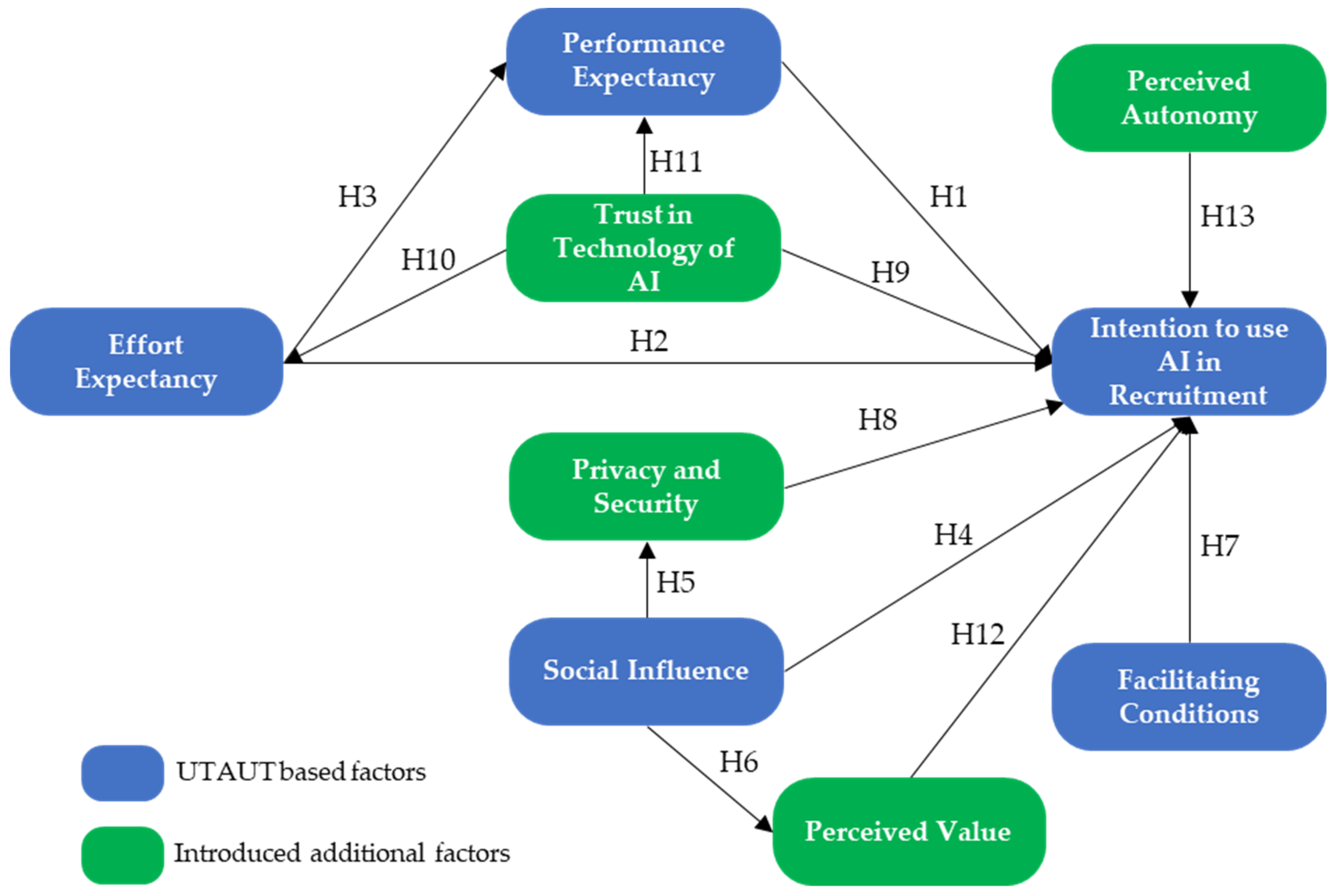
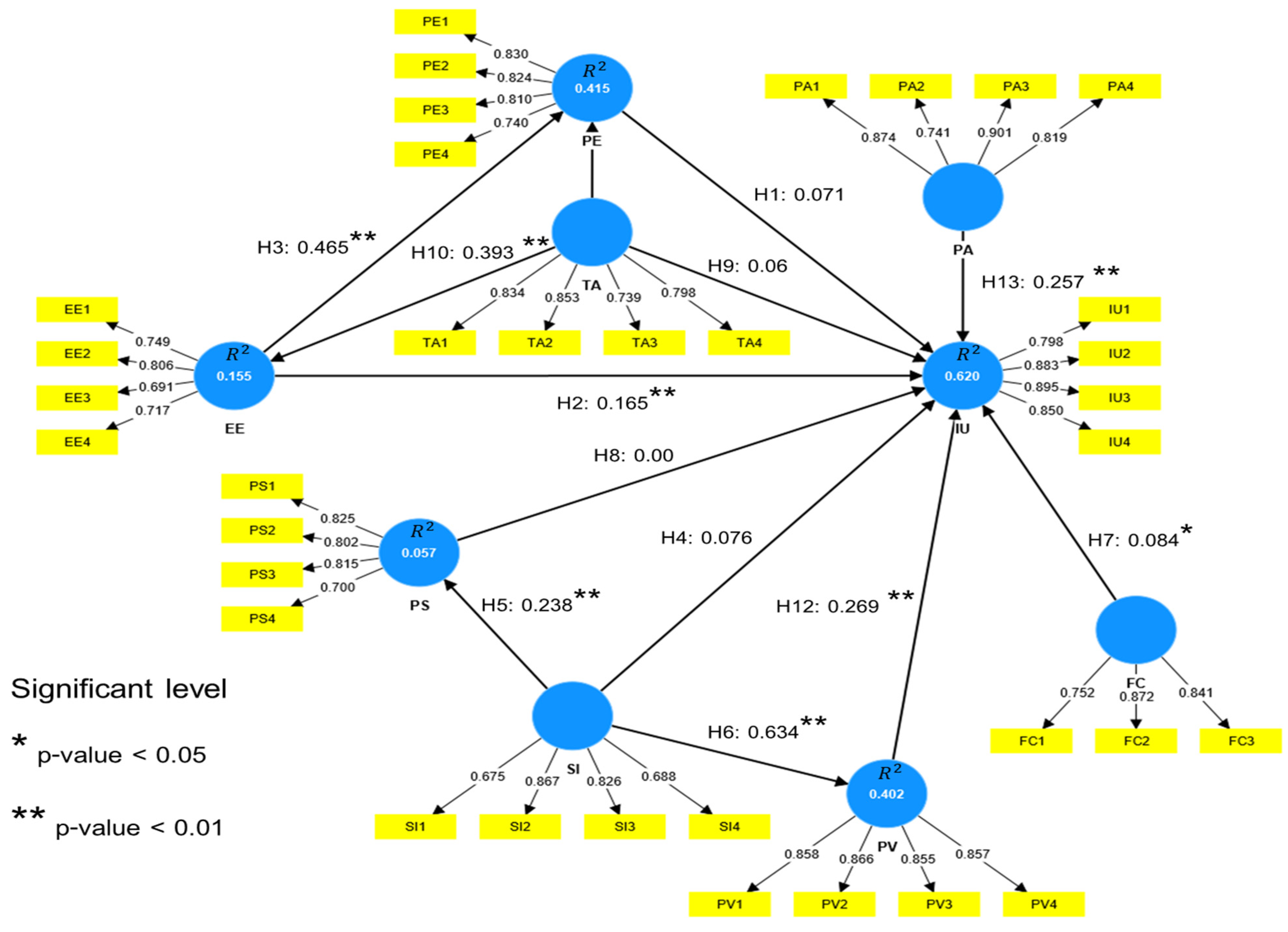
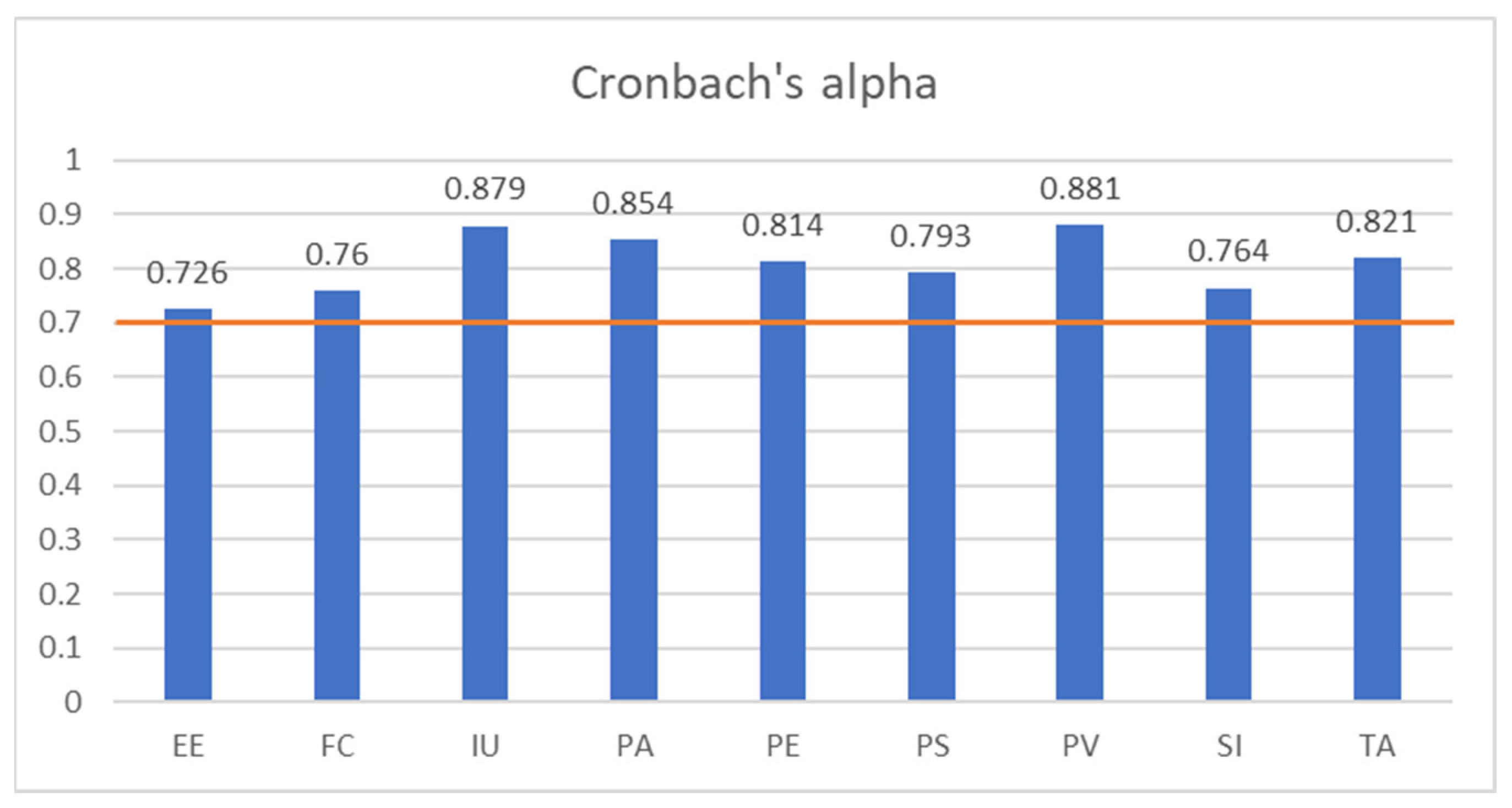
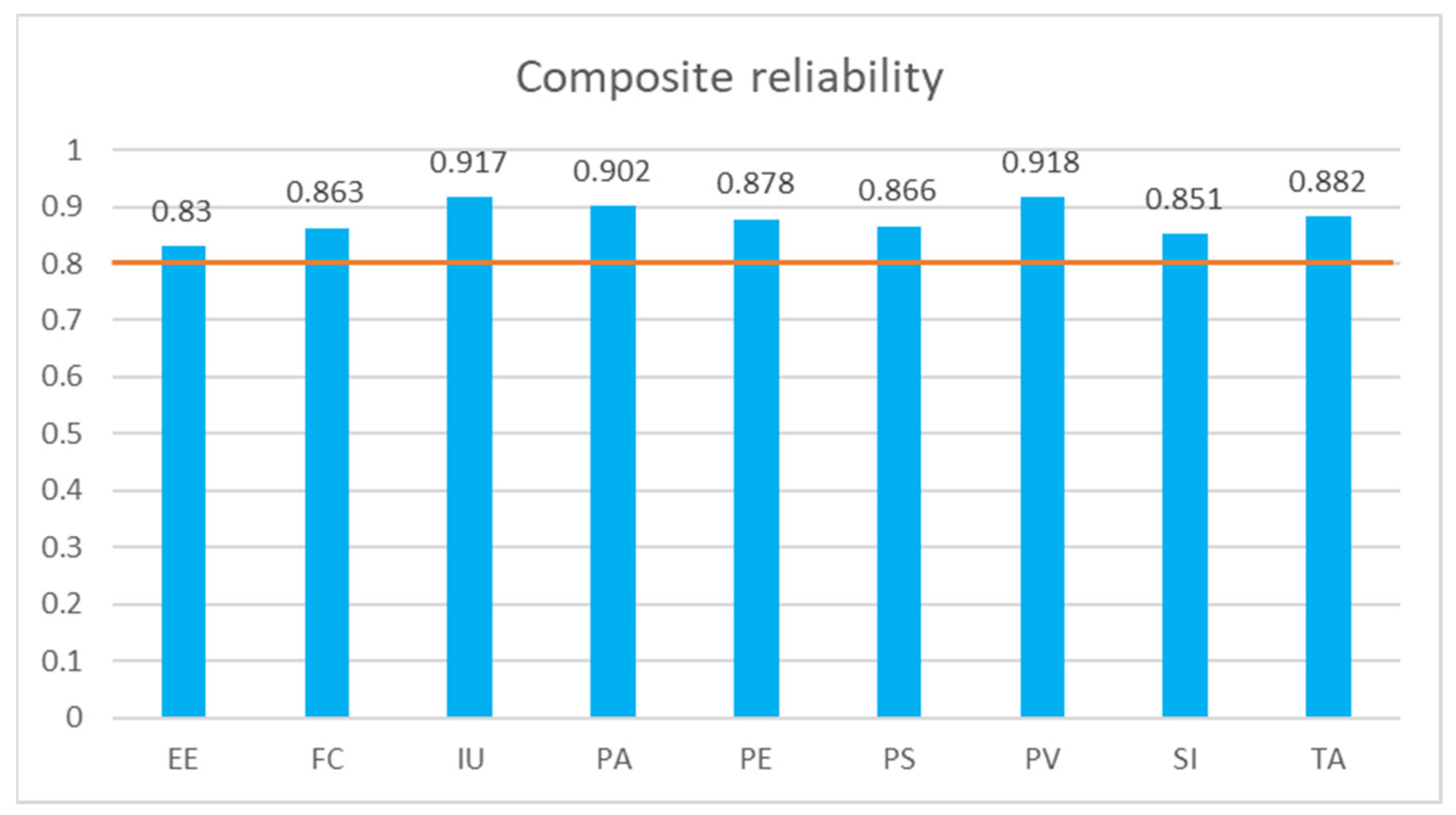
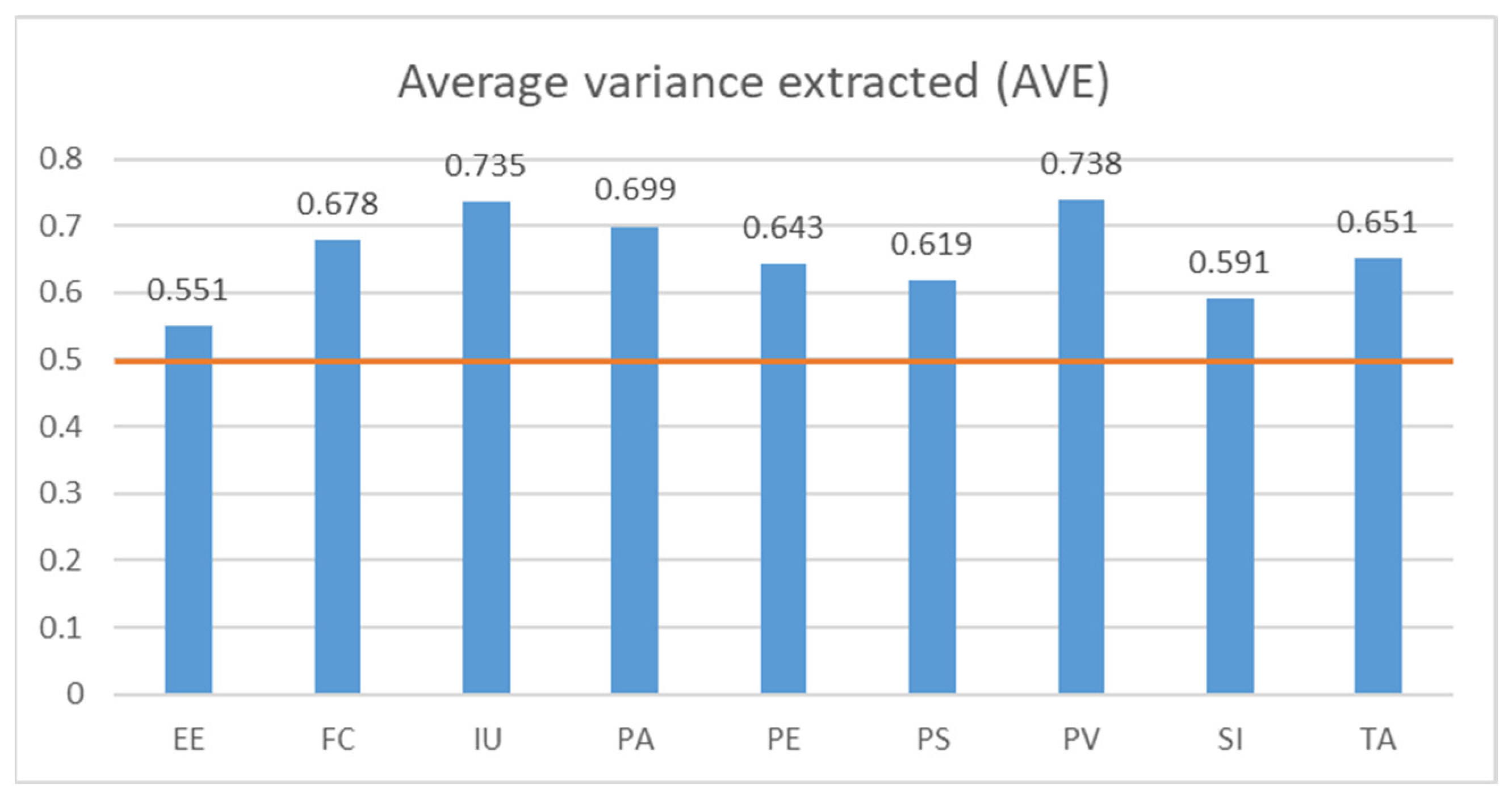
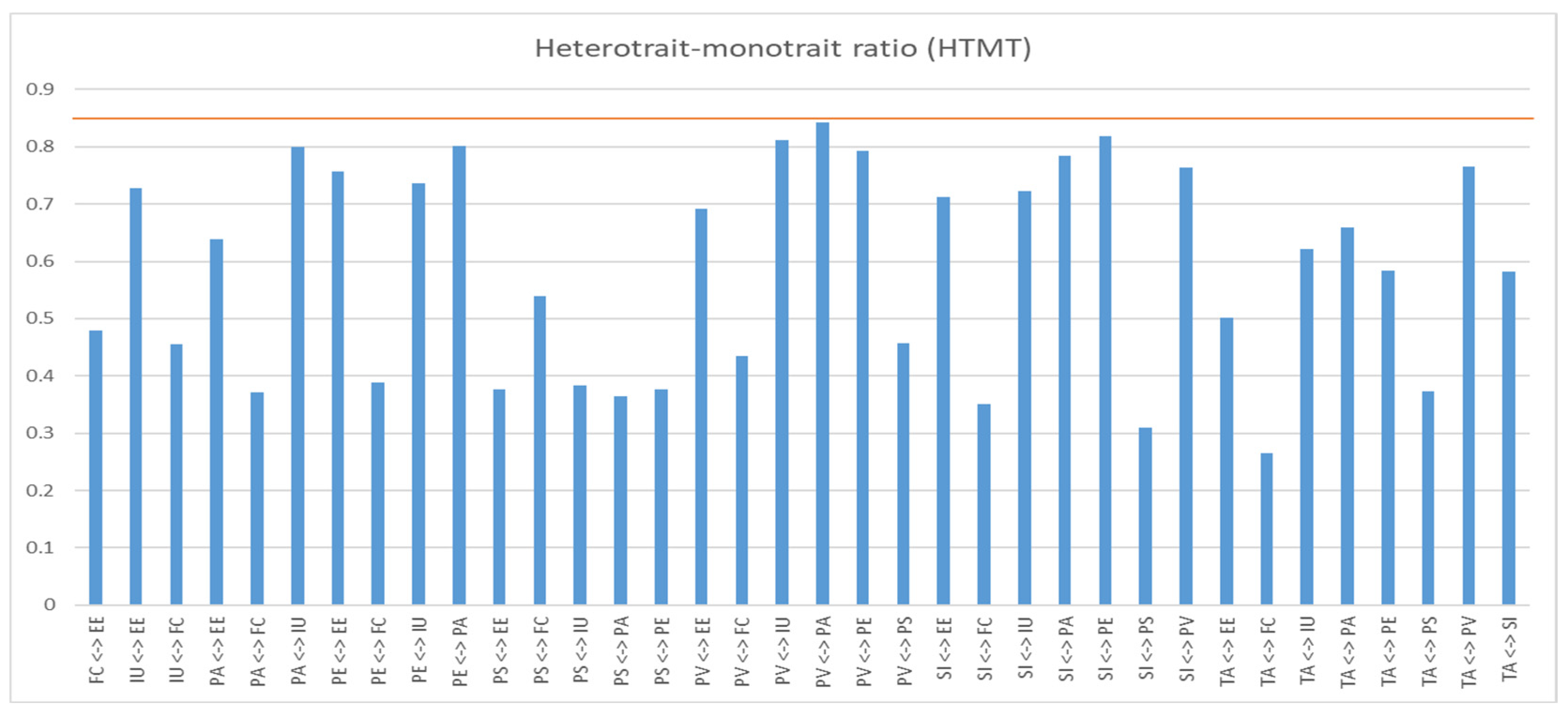
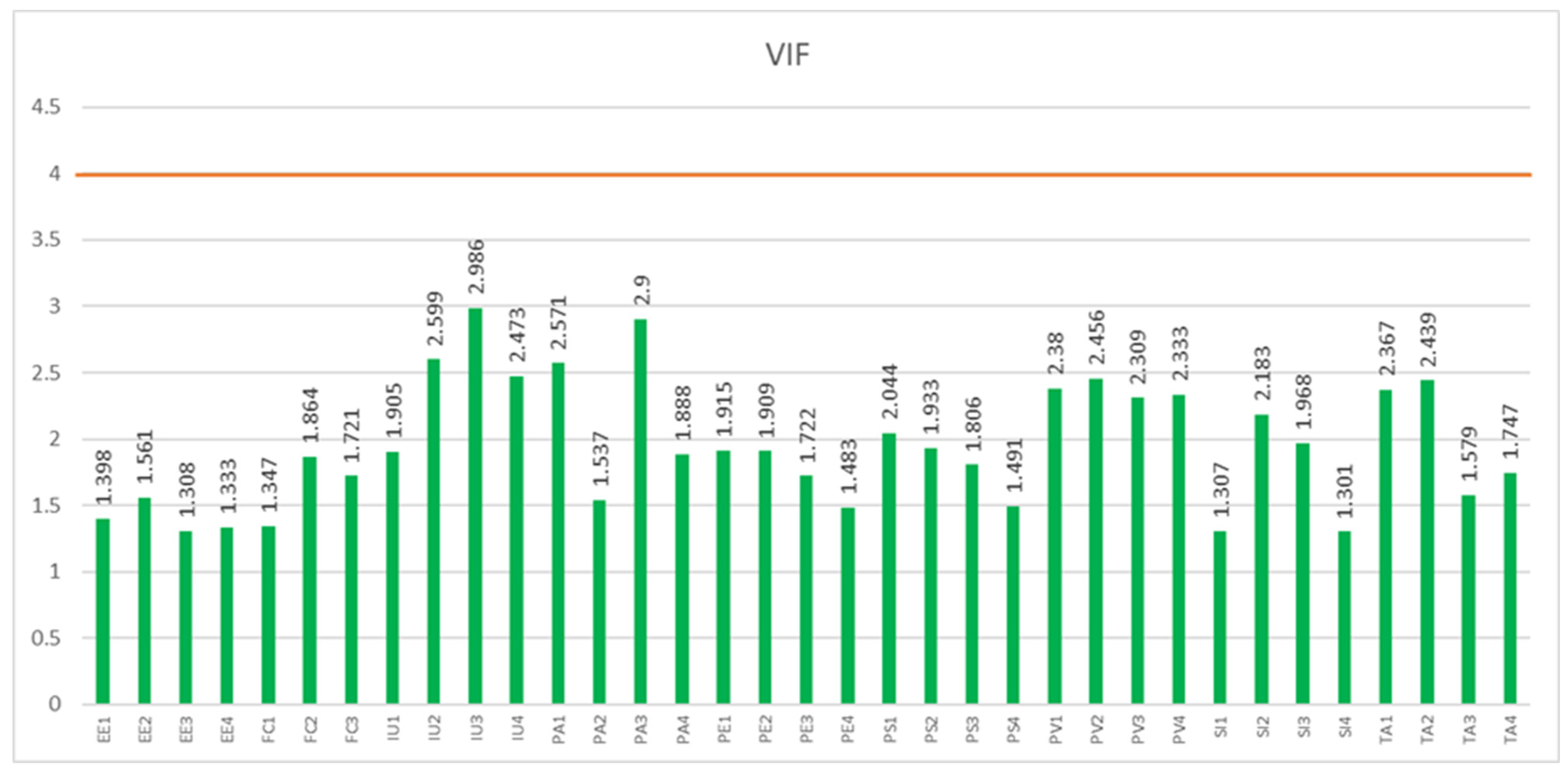
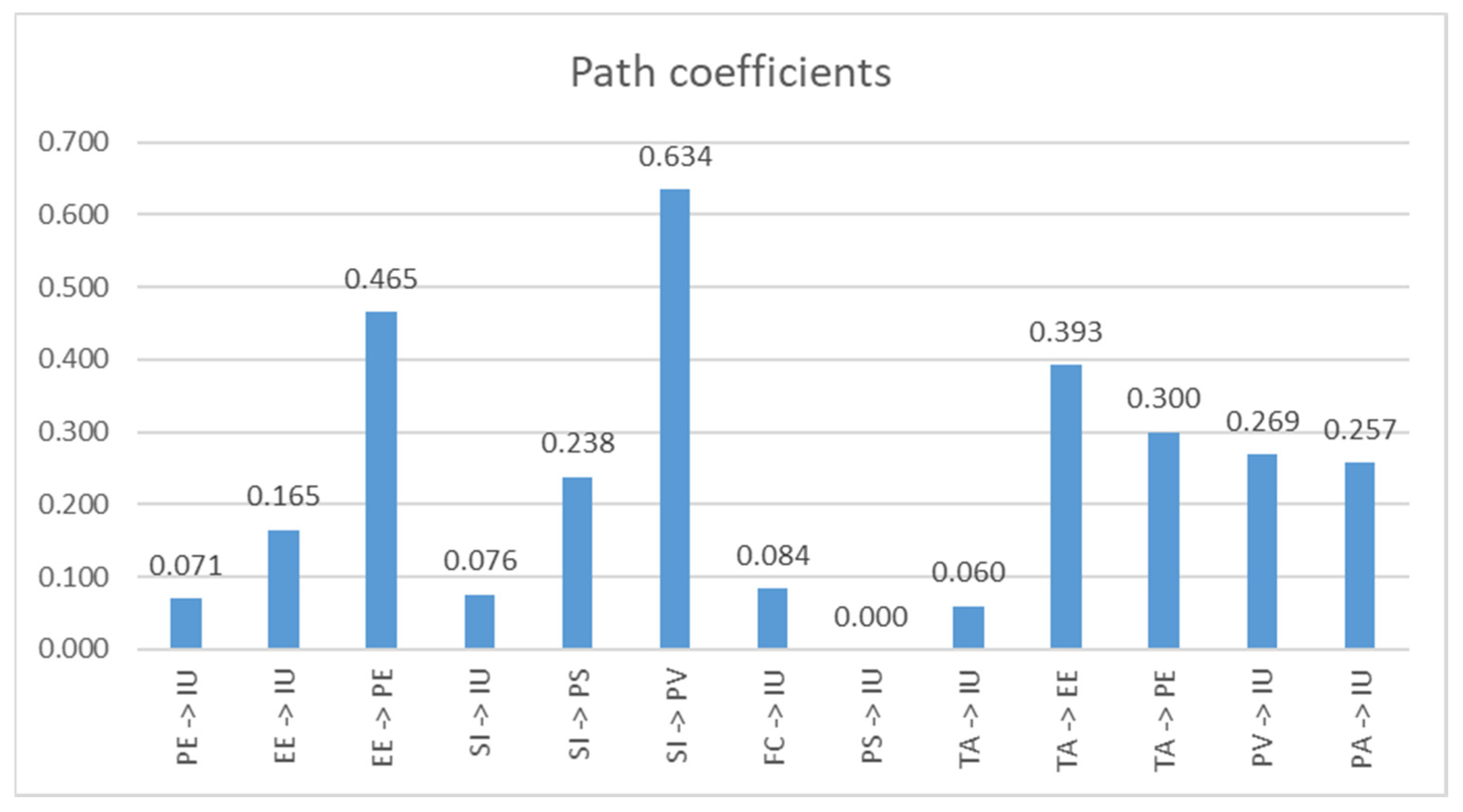
| No. | Age | Education Level | Occupation/Position | PE | EE | SI | FC | PS | TA | PV | PA |
|---|---|---|---|---|---|---|---|---|---|---|---|
| J1 | 37 | Bachelor | Engineer | x | x | x | x | x | x | ||
| J2 | 32 | PhD | Market researcher | x | x | x | x | x | x | x | x |
| J3 | 36 | Bachelor | Engineer | x | x | x | x | x | x | ||
| J4 | 34 | Bachelor | Business developer | x | x | x | x | x | x | x | x |
| J5 | 32 | Master | Data scientist | x | x | x | x | ||||
| J6 | 36 | Master | Programmer | x | x | x | x | x | x | x | x |
| J7 | 23 | Bachelor | Business analyst | x | x | x | x | ||||
| HR1 | 23 | Bachelor | HR/Recruitment officer | x | x | x | x | x | x | x | |
| HR2 | 25 | Bachelor | HR/Recruitment officer | x | x | x | x | x | x | x | x |
| HR3 | 24 | Bachelor | HR/Recruitment officer | x | x | x | x | x | |||
| HR4 | 39 | Master | HR Manager | x | x | x | x | x | x | x | x |
| HR5 | 33 | Master | HR/Recruitment officer | x | x | x | x | x | x | x | x |
| HR6 | 30 | Master | HR generalist | x | x | x | x | x | x | x | x |
| HR7 | 40 | Master | People Director | x | x | x | x | x | |||
| HR8 | 39 | Master | General manager—HR | x | x | x | x | x | x | x | |
| HM1 | 34 | Master | Business development | x | x | x | x | x | x | ||
| HM2 | 37 | Bachelor | Digital head | x | x | x | x | x | x | x | |
| HM3 | 36 | Master | Production manager | x | x | x | x | x | |||
| HM4 | 37 | Master | Head of Marketing | x | x | x | x | ||||
| HM5 | 42 | Bachelor | Managing Director | x | x | x | x | x | x | x |
| Categories | Dimensions | N | % |
|---|---|---|---|
| Gender | Male | 153 | 42% |
| Female | 211 | 58% | |
| Age | Younger than 25 years | 25 | 7% |
| 25–34 years | 165 | 45% | |
| 35–44 years | 121 | 33% | |
| 45–54 years | 45 | 12% | |
| 55 years or older | 8 | 2% | |
| Education Level | Doctorate | 4 | 1% |
| Master’s | 148 | 41% | |
| Bachelor’s | 212 | 58% | |
| Position Level | Officer/Staff | 131 | 36% |
| Supervisor/Team Leader | 82 | 23% | |
| Manager/Department Head | 119 | 33% | |
| Director/Executive | 32 | 9% | |
| Work Experience | 0–3 years | 43 | 12% |
| 3–5 years | 53 | 15% | |
| 5–10 years | 99 | 27% | |
| 10–15 years | 78 | 21% | |
| 15 years or more | 91 | 25% | |
| Organization Size (# of Employees) | Less than 25 | 13 | 4% |
| 26–50 | 43 | 12% | |
| 51–200 | 93 | 26% | |
| 201–500 | 78 | 21% | |
| More than 500 | 137 | 38% | |
| Business Sector | Agro & Food Industry | 19 | 5% |
| Information Technology | 67 | 18% | |
| Manufacturers | 57 | 16% | |
| Medical and Healthcare | 16 | 4% | |
| Financials | 27 | 7% | |
| Consultancy | 36 | 10% | |
| Services | 43 | 12% | |
| Energy and Utilities | 27 | 7% | |
| Consumer Products | 33 | 9% | |
| Others | 39 | 11% | |
| Do you know AI based recruitment software before? | Yes | 299 | 82% |
| No | 65 | 18% | |
| Have you ever used AI based recruitment software before? | Yes | 110 | 30% |
| No | 254 | 70% | |
| Do you think AI based recruitment can replace human? | Yes | 128 | 35% |
| No | 236 | 65% | |
| Total | 364 | 100% |
| Factors | Cronbach’s Alpha (α) | Composite Reliability (CR) | Average Variance Extracted (AVE) |
|---|---|---|---|
| EE | 0.726 | 0.83 | 0.551 |
| FC | 0.76 | 0.863 | 0.678 |
| IU | 0.879 | 0.917 | 0.735 |
| PA | 0.854 | 0.902 | 0.699 |
| PE | 0.814 | 0.878 | 0.643 |
| PS | 0.793 | 0.866 | 0.619 |
| PV | 0.881 | 0.918 | 0.738 |
| SI | 0.764 | 0.851 | 0.591 |
| TA | 0.821 | 0.882 | 0.651 |
| EE | FC | IU | PA | PE | PS | PV | SI | TA | |
|---|---|---|---|---|---|---|---|---|---|
| EE | 0.742 | ||||||||
| FC | 0.356 | 0.823 | |||||||
| IU | 0.581 | 0.372 | 0.857 | ||||||
| PA | 0.507 | 0.305 | 0.694 | 0.836 | |||||
| PE | 0.583 | 0.305 | 0.626 | 0.670 | 0.802 | ||||
| PS | 0.286 | 0.426 | 0.319 | 0.300 | 0.300 | 0.787 | |||
| PV | 0.555 | 0.354 | 0.714 | 0.731 | 0.671 | 0.377 | 0.859 | ||
| SI | 0.539 | 0.264 | 0.598 | 0.639 | 0.66 | 0.238 | 0.634 | 0.769 | |
| TA | 0.393 | 0.213 | 0.532 | 0.555 | 0.482 | 0.294 | 0.655 | 0.463 | 0.807 |
| Hypothesis | Correlation | Path Coefficients (β) | T-Statistics | p-Values | Decision |
|---|---|---|---|---|---|
| H1 | PE -> IU | 0.071 | 1.065 | 0.287 | Not Supported |
| H2 | EE -> IU | 0.165 | 3.208 | 0.001 | Supported |
| H3 | EE -> PE | 0.465 | 10.996 | 0.000 | Supported |
| H4 | SI -> IU | 0.076 | 1.203 | 0.229 | Not Supported |
| H5 | SI -> PS | 0.238 | 4.208 | 0.000 | Supported |
| H6 | SI -> PV | 0.634 | 18.272 | 0.000 | Supported |
| H7 | FC -> IU | 0.084 | 2.217 | 0.027 | Supported |
| H8 | PS -> IU | 0.000 | 0.006 | 0.995 | Not Supported |
| H9 | TA -> IU | 0.060 | 1.279 | 0.201 | Not Supported |
| H10 | TA -> EE | 0.393 | 7.725 | 0.000 | Supported |
| H11 | TA -> PE | 0.300 | 6.777 | 0.000 | Supported |
| H12 | PV -> IU | 0.269 | 4.132 | 0.000 | Supported |
| H13 | PA -> IU | 0.257 | 3.877 | 0.000 | Supported |
| R-Square | R-Square Adjusted | |
|---|---|---|
| IU | 0.620 | 0.612 |
| PE | 0.415 | 0.412 |
| PV | 0.402 | 0.400 |
Disclaimer/Publisher’s Note: The statements, opinions and data contained in all publications are solely those of the individual author(s) and contributor(s) and not of MDPI and/or the editor(s). MDPI and/or the editor(s) disclaim responsibility for any injury to people or property resulting from any ideas, methods, instructions or products referred to in the content. |
© 2024 by the authors. Licensee MDPI, Basel, Switzerland. This article is an open access article distributed under the terms and conditions of the Creative Commons Attribution (CC BY) license (https://creativecommons.org/licenses/by/4.0/).
Share and Cite
Tanantong, T.; Wongras, P. A UTAUT-Based Framework for Analyzing Users’ Intention to Adopt Artificial Intelligence in Human Resource Recruitment: A Case Study of Thailand. Systems 2024, 12, 28. https://doi.org/10.3390/systems12010028
Tanantong T, Wongras P. A UTAUT-Based Framework for Analyzing Users’ Intention to Adopt Artificial Intelligence in Human Resource Recruitment: A Case Study of Thailand. Systems. 2024; 12(1):28. https://doi.org/10.3390/systems12010028
Chicago/Turabian StyleTanantong, Tanatorn, and Piriyapong Wongras. 2024. "A UTAUT-Based Framework for Analyzing Users’ Intention to Adopt Artificial Intelligence in Human Resource Recruitment: A Case Study of Thailand" Systems 12, no. 1: 28. https://doi.org/10.3390/systems12010028
APA StyleTanantong, T., & Wongras, P. (2024). A UTAUT-Based Framework for Analyzing Users’ Intention to Adopt Artificial Intelligence in Human Resource Recruitment: A Case Study of Thailand. Systems, 12(1), 28. https://doi.org/10.3390/systems12010028






